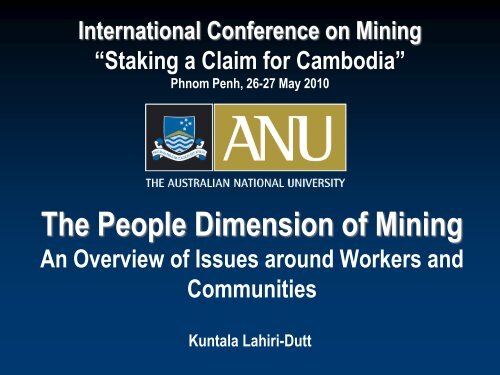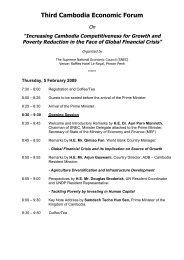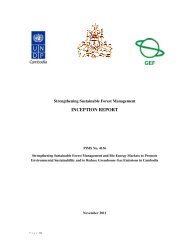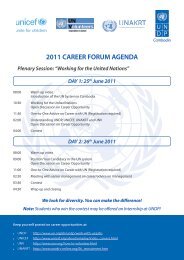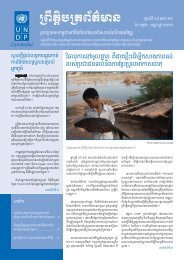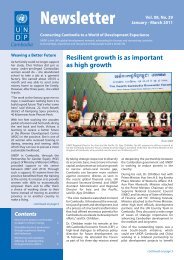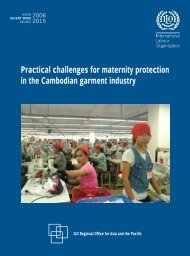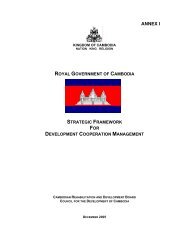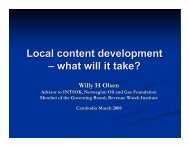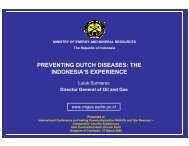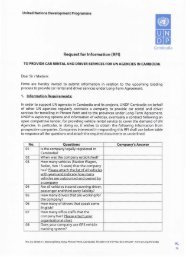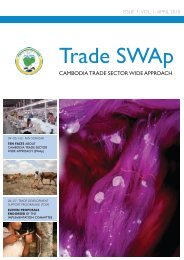14.Dr.Kuntala Lahiri-Dutt - The People Dimension of Mining.pdf
14.Dr.Kuntala Lahiri-Dutt - The People Dimension of Mining.pdf
14.Dr.Kuntala Lahiri-Dutt - The People Dimension of Mining.pdf
Create successful ePaper yourself
Turn your PDF publications into a flip-book with our unique Google optimized e-Paper software.
International Conference on <strong>Mining</strong><br />
“Staking a Claim for Cambodia”<br />
Phnom Penh, 26-27 May 2010<br />
<strong>The</strong> <strong>People</strong> <strong>Dimension</strong> <strong>of</strong> <strong>Mining</strong><br />
An Overview <strong>of</strong> Issues around Workers and<br />
Communities<br />
<strong>Kuntala</strong> <strong>Lahiri</strong>-<strong>Dutt</strong>
Summary <strong>of</strong> Presentation<br />
• A broad overview <strong>of</strong> the people issues in mining & the<br />
leading practices<br />
• <strong>Mining</strong> & community – external<br />
• <strong>Mining</strong> & workers – internal<br />
• <strong>Mining</strong> & gender – women in mines as workers, impacts<br />
• What is mining? Who are these people?<br />
• Show how people can be viewed not as trouble but as<br />
treasures in mining<br />
• Steps to be taken - throughout the mining project cycle<br />
• In context <strong>of</strong> this country<br />
• Indicate to resources for further consultation<br />
Full paper can be used for detailed information
„Overburdens‟ or treasure?<br />
Are people a problem for mining-development? Can „social<br />
blindness‟ be a solution?<br />
<strong>The</strong> story <strong>of</strong> Bougainville: PNG, 1988.<br />
• A „rebellion‟, for lack <strong>of</strong> compensation or sudden influx <strong>of</strong><br />
money pouring into communities not used to cash?<br />
• Similar protests – Phulbari project in Bangladesh, bauxite<br />
mining in Orissa hills in India
What is the evidence?<br />
<strong>Mining</strong> & the national economy<br />
Positive Effects<br />
• Mineral revenue – „resource rent‟<br />
• Employment – direct & indirect<br />
• Infrastructure, construction<br />
Negative Effects<br />
• May decelerate economic development – „Resource curse‟<br />
• Causes a decay in agricultural sector – „Dutch disease‟<br />
• Creates enclaves <strong>of</strong> wealth<br />
• Boosts corruption in resource-rich developing countries
What is the evidence?<br />
<strong>Mining</strong> & the local people<br />
Positive Effects<br />
• Local resource rent<br />
• Infrastructure & construction work<br />
Negative Effects<br />
• Deteriorates the livelihoods <strong>of</strong> the host communities,<br />
• Interferes in local sovereignty,<br />
• Deepens disparities in wealth,<br />
• Only a few jobs for local people, and<br />
• Degrades local environment on which communities depend
Social Impacts <strong>of</strong> <strong>Mining</strong><br />
• In-migration & urbanisation – „boom‟ towns. Local people feel<br />
resentful towards migrants because outsiders usually have<br />
more cash and higher purchasing power than locals<br />
• Social impacts include:<br />
• Community fracture, family disruption, increase in drug use,<br />
gambling, petty crime, importation <strong>of</strong> weapons<br />
• Erosion <strong>of</strong> women‟s roles & status, prostitution & sexually<br />
transmitted diseases (HIV/AIDS)<br />
• Most negative impacts are borne by women<br />
• Relatively self-contained communities experience a loss <strong>of</strong><br />
control, direction & security in their lives
Mineral governance<br />
• In many developing countries, , mineral governance, legislation<br />
and social controls are still relatively weak<br />
• Old laws created during colonial times, inadequate laws,<br />
complex laws, laws that do not reflect contemporary values<br />
such as human rights or pro-poor principles<br />
• CBAA & tribal land<br />
• Land Acquisition Act<br />
• Concession agreements for individual cases<br />
• <strong>Mining</strong> legislation reforms to regulate & accommodate<br />
contemporary changes<br />
• A lot needs to be done to protect the low-skilled, less trained &<br />
poor local people
Poor <strong>People</strong>‟s Relationship with Land<br />
• Four concerns:<br />
• right to ownership & control <strong>of</strong> land<br />
• rights <strong>of</strong> self-determination through informed consent,<br />
participation & engagement<br />
• right to represent themselves through their own institutions, and<br />
• rights to have food security<br />
• Requires deep social & cultural understanding<br />
• Land - not only for subsistence, but a part <strong>of</strong> identity<br />
• Ownership <strong>of</strong> land in „western‟ sense may not even exist in Asia<br />
• Way <strong>of</strong> life: large rivers shift courses and create & destroy land at their will,<br />
and wandering peoples move in & out <strong>of</strong> areas<br />
• <strong>Mining</strong>-Induced Displacement and Resettlement (MIDR)<br />
• >3 million in India, 40% <strong>of</strong> the displaced are tribals
Social Licence to Operate<br />
<strong>The</strong> concept is extra-legal, abstract & ethereal:<br />
[T]he recognition and acceptance <strong>of</strong> a company‟s contribution to the<br />
community in which it operates, while moving beyond meeting basic legal<br />
requirements towards developing and maintaining the constructive<br />
stakeholder relationships necessary for business to be sustainable. Overall,<br />
it comes from striving for relationships based on honesty and mutual<br />
respect.<br />
So far, largely outside the „core business‟ <strong>of</strong> mining, but<br />
fundamentally changes the manner in which mining companies<br />
do business<br />
It implies that society can monitor & measure a project, and<br />
company performance throughout lifecycle <strong>of</strong> a project.
What is mining (through a people<br />
lens)?<br />
• Not only a corporatized entity, with embodied capital owned by<br />
private or public, operating with high level <strong>of</strong> technology in a<br />
large-scale manner<br />
• Fewer people in mechanised mining - only 1% <strong>of</strong> world‟s labour<br />
• Long history – copper age to bronze to iron, but also gold & gem<br />
stones. Artisanal mining – many more people<br />
• Modern mining – introduced through colonialism in Asia, miningled<br />
„enclave‟ type development<br />
• Coal in India, British Malaya and Dutch Indonesia - world‟s<br />
largest tin producers, Coal from French Vietnam<br />
• Push, poverty-induced & rush mining – informal sector. Illegal<br />
mining – to take advantage <strong>of</strong> high commodity prices
<strong>People</strong> as women and Men<br />
Women in mines<br />
• As workers in pre-industrial mines (part <strong>of</strong> family labour unit)<br />
• breaking and sorting <strong>of</strong> ores, hauling and transporting,<br />
smelting and processing, working the windlasses<br />
• Flourished in modern industrial mines – throughout Europe<br />
• Collieries & salt mines in India & Pakistan<br />
• Asian countries – in Japan, Malay<br />
• Need to facilitate women‟s employment<br />
• In ASM in large numbers – informalisation<br />
• Women do not own the lands/mines<br />
Women and mines<br />
• Impacts are generally negative on women – men take cash<br />
compensation, men negotiate, men get the jobs
<strong>People</strong> in the Project Cycle<br />
• Exploration – social mapping, livelihood patterns and coping<br />
strategies, ownership <strong>of</strong> resources, power dynamics <strong>of</strong> different<br />
income groups, ethnicities and genders<br />
• Deposit Evaluation – consultations for „prior and informed<br />
consent‟, beginning <strong>of</strong> community engagement – women must be<br />
a part. Gender analysis – roles <strong>of</strong> women & men<br />
• Mine Planning - Social Impact Assessments, social mapping<br />
surveys, Cultural Impact Assessments and R&R planning<br />
• Construction – community development begins with communityneeds<br />
surveys (men & women have separate needs)<br />
• Mine Operation - Livelihood projects, training & education, credit<br />
to set up small businesses & income generating activities<br />
• Mine Closure – Community consultations, livelihood projects
Thank you!<br />
Akun jann<br />
Contact: kuntala.lahiri-dutt@anu.edu.au


